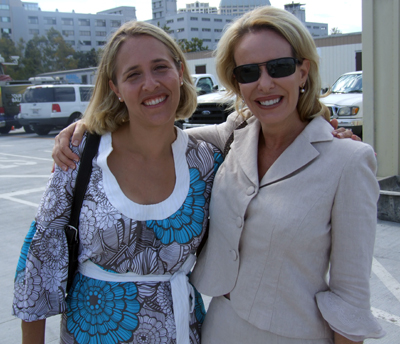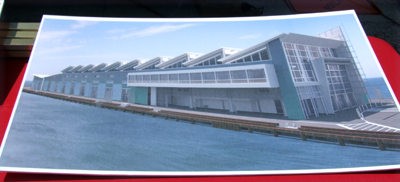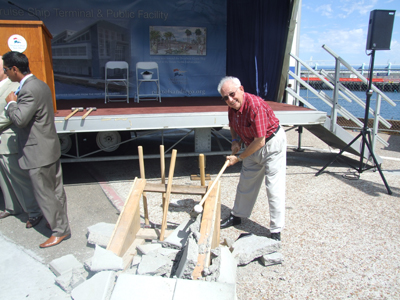|
By Donald H. Harrison
 SAN DIEGO—Although not its main purpose, the auxiliary cruise ship terminal being built on the Broadway Pier will make a terrific place for a bar or bat mitzvah reception, former Port Commissioner Laurie Black commented at “cement-breaking” ceremonies on Tuesday, August 4. SAN DIEGO—Although not its main purpose, the auxiliary cruise ship terminal being built on the Broadway Pier will make a terrific place for a bar or bat mitzvah reception, former Port Commissioner Laurie Black commented at “cement-breaking” ceremonies on Tuesday, August 4.
Black should know. During her term as a Port Commissioner she arranged architectural charrettes to make certain that the new terminal—which will serve as a backup to the current terminal at the B Street Pier –would answer many needs of the community, including downtown function space. And if the subject of a bat mitzvah is on her mind, she can be forgiven: her and husband Robert’s daughter, Maddie Lawrence, will become a bat mitzvah Feb. 13 at Congregation Beth Israel.

What is a cement-breaking ceremony? Well, there is no ground of the earthen variety to break on a pier, so the Port District improvised a ceremony to commemorate the beginning of construction of the new Broadway Terminal. Stephen Cushman, who serves as chairman of the Board of Port Commissioners this year, had current commissioners as well as Black grab sledge hammers and smash through some concrete that had been fashioned for the purpose.

The Jewish community was represented at the occasion not only by Cushman and Black, who were physically present , but also by several glowing references to Israeli-American businessman Mickey Arison, chairman of Carnival Cruise Lines, and to Giora Israel, the company’s senior vice president.
Giora Israel had helped negotiate the arrangement by which Carnival loaned $12 million to the Port -- $10 million for construction of the Broadway Cruise Terminal and $2 million for improvements to the B Street Cruise Terminal, which can handle two ships simultaneously.
Carnival is both a cruise line and an owner of nine other cruise lines—including some familiar big brands such as Holland America, Princess and Cunard. The company was represented at the ceremony by Carlos Torres de Navarra, its director of strategic planning, who said the pier’s construction indicates that despite recent tough economic times, Carnival has confidence in the future of the cruise ship industry.
The 52,000-square foot, two-story Broadway Cruise Terminal is due to be completed in December 2010 by Jayne Corporation, the contractor.
Not only will the Broadway Cruise Terminal be beautiful, but it also will be functional, able to accommodate 2,600 passengers, Navarra said.
Architect Luis Ajamil of Miami-based Bernello Ajami & Partners said the rededication of the 96-year-old Broadway Pier marks a new era in the world of transportation.
Go to top of right column
|
|

Originally, he said, passenger ships provided most transportation between countries separated by oceans. When jet planes were developed, passenger shipping was eclipsed. Today, in San Diego and in other countries around the world,
piers and waterfront lands are being redeveloped to accommodate cruise ships catering to leisure travelers.
Among many projects to which Ajamil's firm is a planner or consultant are cruise projects in Dubai; Singapore, Ft. Lauderdale, Florida; Ketchikan, Alaska, and Brooklyn, N.Y.
Ajamil said that the Broadway Cruise Terminal will be the first in the world to be LEED (Leadership in Energy and Environmental Design) certified,. The facility will include solar panels, low-flow toilets, water saving plumbing fictures, and reflecting paint on the roof.
Cushman said that the pier even will have an electrical hookup for one visiting ship per day, allowing that ship to shut down its engines and thereby reduce emissions into the atmosphere.
This “historic first” doesn’t come without the passing of another historic structure – the “mushroom” which was a small building , now demolished, that was at the end of the pier.

Allan J. Rappoport , formerly director of U.S. Customs for San Diego and now a member of the Port’s Cruise Industry Advisory Committee, said that the small mushroom-shaped building served as security headquarters whenever a visiting VIP came to San Diego Bay.
Rappoport, another Jewish community member, recalled that when Queen Elizabeth II of England arrived in San Diego in her royal yacht Britannia in 1983, the building was taken over by a combination of American and British security agents. He said they drilled all kinds of holes for electronics and communications equipment. When other VIPs would visit, he said, more holes would be drilled until after a while, the building had the aspect of Swiss cheese.
“I wouldn’t be surprised if they didn’t have to pull it down; they probably could have blown it over,” Rappoport quipped.
The demolition of the small structure means that meeting rooms at the back of the terminal can have unimpeded views of San Diego Bay and also of the USS Midway, located immediately to the south of the Broadway Pier on Harbor Drive. The Broadway Cruise Terminal's design will allow indoor-outdoor combination uses of the space—what Black had in mind for summer bar and bat mitzvah receptions.
With 297 port calls made in San Diego last year—some by homeported ships that purchase supplies here, and some by visiting ships stopping en route to their destinations—the cruise ship industry brings billions of dollars in fees, passenger spending, and provisions to the San Diego economy. It is estimated that each home-ported ship represents a $2 million boost per turnaround to San Diego’s economy.
In that San Diego is a tourist destination, Cushman had instructions for the business crowd that had assembled in warm weather on the pier for the 10 a.m. ceremony.
“Everybody take off their jackets,” he said to general approbation, shedding his own.
| |

